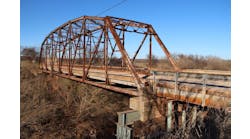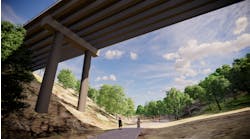The California Department of Transportation (Caltrans) manages a complex network of highways and bridges traversing snowy mountain passes, coastal areas, urban centers and barren deserts.
The magnitude of this transportation system, diverse use characteristics and variable climatic regions make bridge management a challenge.
Even with the diverse nature of California’s bridges, Caltrans has been able to reduce the number of its structurally deficient bridges by 32% over the past five years. The improvement in bridge condition has been accomplished at the same time that scour and seismic vulnerabilities were reduced. These accomplishments have been achieved through a combination of management strategies, a strong preservation focus, supportive policies and clear performance goals.
Caltrans bridge management relies on a three-pronged approach built on condition assessments and recommendations made by our inspecting engineers. The inspection recommendations, along with bridge needs identified through analysis, are sub-divided into three major categories: crew work, preservation needs and major capital rehabilitation, mitigation and replacement projects.
Caltrans bridge crews operating regionally are our first line of defense against bridge deterioration. The crews fix minor problems, paint bridges and respond to incident damage as needed. The crew work is done in accordance with established repair procedures that do not require plans, specifications or other project-development costs. These repairs are very rapid and highly cost-effective.
In 2005, a state law was passed requiring the department to produce a Five-Year Maintenance Plan. The plan presents the maintenance needs on the highways and bridges and establishes funding levels necessary to achieve defined performance outcomes. The five-year strategy is updated every other year and has provided a means to regularly communicate the maintenance needs on the system. The plan focuses on preservation activities and the resulting cost avoidance in the major capital programs achieved through preservation. Through the plan, Caltrans has been able to increase preservation funding by shifting funds from rehabilitation and replacement programs to proactive preservation activities. The shift of funding to preservation strategies has resulted in a 40% reduction in the number of new rehabilitation and replacement needs identified annually.
Even with aggressive preservation programs in place, bridges still require rehabilitation or replacement when maintenance is no longer cost-effective. Major capital projects are evaluated in a multi-objective bridge-management framework that allows prioritization of projects based on benefit-to-cost ratios. The framework allows for prioritization of condition-based needs, safety improvements, operational improvements and vulnerability mitigation projects. Caltrans communicates the major transportation system needs through a Ten-Year Plan. The Ten-Year Plan presents the unconstrained needs of the system and a fiscally constrained project plan based on available funding. This plan is updated every two years to accommodate newly identified needs and changes in priorities.
Caltrans uses five primary performance measures to monitor trends in condition and risk mitigation to evaluate the effectiveness of its bridge-management strategies and policies. This regular tracking of performance measures and the flexibility to direct funding to needed areas has been essential to the program’s effectiveness.
Caltrans has been able to improve bridge conditions through sound management policies, economic prioritization and performance management. Each of the players—from the inspectors to the crews performing rapid repairs to the engineers evaluating, prioritizing and developing projects—play an integral role in the overall effectiveness of the Caltrans bridge-management program. R&B


